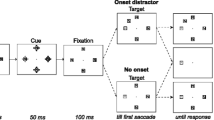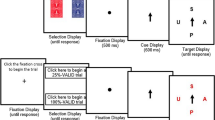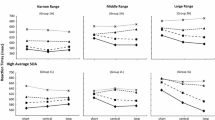Abstract
Voluntary orienting of spatial attention is typically investigated by visually presented directional cues, which are called predictive when they indicate where the target is more likely to appear. In this study, we investigated the nature of the potential link between cue predictivity (the proportion of valid trials) and the strength of the resulting covert orienting of attention. Participants judged the orientation of a unilateral Gabor grating preceded by a centrally presented, non-directional, color cue, arbitrarily prompting a leftwards or rightwards shift of attention. Unknown to them, cue predictivity was manipulated across blocks, whereby the cue was only predictive for either the first or the second half of the experiment. Our results show that the cueing effects were strongly influenced by the change in predictivity. This influence differently emerged in response speed and accuracy. The speed difference between valid and invalid trials was significantly larger when cues were predictive, and the amplitude of this effect was modulated at the single trial level by the recent trial history. Complementary to these findings, accuracy revealed a robust effect of block history and also a different time-course compared with speed, as if it mainly mirrored voluntary processes. These findings, obtained with a new manipulation and using arbitrary non-directional cueing, demonstrate that cue-target contingencies strongly modulate the way attention is deployed in space.



Similar content being viewed by others
Notes
Of note, the two levels of cue predictivity/proportion valid used here are only indicative because “real” cue predictivity/proportion valid changes on trial-by-trial basis.
References
Abrahamse, E., Braem, S., Notebaert, W., & Verguts, T. (2016). Grounding cognitive control in associative learning. Psychological Bulletin, 142, 693–728.
Alamia, A., Orban de Xivry, J. J., San Anton, E., Olivier, E., Cleeremans, A., & Zenon, A. (2016). Unconscious associative learning with conscious cues. Neuroscience of Consciousness, 1–10. doi:10.1093/nc/niw016
Awh, E., Belopolsky, A. V., & Theeuwes, J. (2012). Top-down versus bottom-up attentional control: a failed theoretical dichotomy. Trends in Cognitive Sciences, 16, 437–443.
Bartolomeo, P., Decaix, C., & Siéroff, E. (2007). The phenomenology of endogenous orienting. Consciousness and Cognition, 16, 144–161.
Bates, D., Maechler, M., Bolker, B., & Walker, S. (2014). lme4: Linear mixed-effects models using Eigen and S4. R package version 1.1-7. Retrieved from http://cran.r-project.org/package=lme4.
Bonato, M. (2012). Neglect and extinction depend greatly on task demands: a review. Frontiers in Human Neuroscience, 6, 195.
Bonato, M. (2015). Unveiling residual, spontaneous recovery from subtle hemispatial neglect three years after stroke. Frontiers in Human Neuroscience, 9, 413.
Bonato, M., Priftis, K., Marenzi, R., & Zorzi, M. (2009). Normal and impaired reflexive orienting of attention after central nonpredictive cues. Journal of Cognitive Neuroscience, 21, 745–759.
Box, G. E. P., & Cox, D. R. (1964a). An analysis of transformations. Journal of the Royal Statisistical Society, Series B, 26, 211–246.
Box, G. E. P., & Cox, R. (1964b). An Analysis of transformations. Journal of the Royal Statistical Society: Series B (Methodological), 26(2), 211–252.
Braem, S., Hickey, C., Duthoo, W., & Notebaert, W. (2014). Reward determines the context-sensitivity of cognitive control. Journal of Experimental Psychology: Human Perception and Performance, 40, 1769–1778. doi:10.1037/a0037554.
Carrasco, M. (2011). Visual attention: The past 25 years. Vision Research, 51, 1484–1525.
Chica, A. B., & Bartolomeo, P. (2010). Unconscious strategies? Commentary on Risko and Stolz (2010): The proportion valid effect in covert orienting: Strategic control or implicit learning? Consciousness and Cognition, 91, 443–444.
Chica, A. B., Martín-Arévalo, E., Botta, F., & Lupiáñez, J. (2014). The Spatial Orienting paradigm: how to design and interpret spatial attention experiments. Neuroscience & Biobehavioural Reviews, 40, 35–51. doi:10.1016/j.neubiorev.2014.01.002.
Corbetta, M., & Shulman, G. L. (2011). Spatial neglect and attention networks. Annual Review of Neuroscience, 34, 569–599.
Cronbach, L. J., & Furby, L. (1970). How we should measure “change”: Or should we? Psychological Bulletin, 74, 68–80.
Cutini, S., Scatturin, P., Menon, E., Bisiacchi, P. S., Gamberini, L., Zorzi, M., & Dell’Acqua, R. (2008). Selective activation of the superior frontal gyrus in task-switching: an event-related fNIRS study. NeuroImage, 42, 945–955.
Dobbins, I. G. (2004). Cortical activity reductions during repetition priming can result from rapid response learning. Nature, 428, 316–319.
Dombert, P. L., Fink, G. R., & Vossel, S. (2016). The impact of probabilistic feature cueing depends on the level of cue abstraction. Experimental Brain Research, 234, 685–694.
Doricchi, F., Macci, E., Silvetti, M., & Macaluso, E. (2010). Neural correlates of the spatial and expectancy components of endogenous and stimulus-driven orienting of attention in the posner task. Cerebral Cortex, 20, 1574–1585.
Duthoo, W., Abrahamse, E. L., Braem, S., Boehler, C. N., & Notebaert, W. (2014). The heterogeneous world of congruency sequence effects: an update. Frontiers in Psychology, 5, 1001.
Efron, B., & Tibshirani, R. (1986). Bootstrap methods for standard errors, confidence intervals, and other measures of statistical accuracy. Statistical Science, 1(1), 54–75. Retrieved from http://www.jstor.org/stable/2245500.
Eimer, M. (1997). Uninformative symbolic cues may bias visual-spatial attention: behavioral and electrophysiological evidence. Biological Psychology, 46, 67–71.
Eriksen, C. W., & Yeh, Y. Y. (1985). Allocation of attention in the visual field. Journal of Experimental Psychology: Human Perception and Performance, 11, 583–587.
Fuchs, I., & Ansorge, U. (2012). Unconscious cueing via the superior colliculi: Evidence from searching for onset and color targets. Brain Sciences, 2, 33–60.
Fuchs, I., Ansorge, U., Huber-Huber, C., Höflich, A., & Lanzenberger, R. (2015). S-ketamine influences strategic allocation of attention but not exogenous capture of attention. Consciousness and Cognition, 35, 282–294.
Hommel, B., Pratt, J., Colzato, L., & Godijn, R. (2001). Symbolic control of visual attention. Psychological Science, 12, 360–365.
Johnson, D. N., & Yantis, S. (1995). Allocating visual attention: Tests of a two-process model. Journal of Experimental Psychology: Human Perception and Performance, 21, 1376–1390.
Jonides, J. (1981). Voluntary versus automatic control over the mind’s eye’s movement. In J. B. Long & A. D. Baddeley (Eds.), Attention and performance IX (pp. 187–203). Hillsdale, NJ: Erlbaum.
Kaernbach, C. (1991). Simple adaptive testing with the weighted up-down method. Perception and Psychophysics, 49(3), 227–229.
Kinoshita, S., Mozer, M. C., & Forster, K. I. (2011). Dynamic adaptation to history of trial difficulty explains the effect of congruency proportion on masked priming. Journal of Experimental Psychology: General, 140(4), 622–636.
Koshino, H., Warner, C. B., & Juola, J. F. (1992). Relative effectiveness of central, peripheral, and abrupt-onset cues in visual attention. Quarterly Journal of Experimental Psychology, 45(4), 609–631.
Lambert, A., Naikar, N., McLachlan, K., & Aitken, V. (1999). A new component of visual orienting: Implicit effects of peripheral information and subthreshold cues on covert attention. Journal of Experimental Psychology: Human Perception and Performance, 25, 321–340.
Lambert, A., Roser, M., Wells, I., & Heffer, C. (2006). The spatial correspondence hypothesis and orienting in response to central and peripheral spatial cues. Visual Cognition, 13(1), 65–88.
Logan, G. D. (1990). Repetition priming and automaticity: Common underlying mechanisms? Cognitive Psychology, 22, 1–35.
López-Ramón, M. F., Chica, A. B., Bartolomeo, P., & Lupiáñez, J. (2011). Attentional orienting and awareness: Evidence from a discrimination task. Consciousness and Cognition, 20, 745–755.
Losier, B. J., & Klein, R. M. (2001). A review of the evidence for a disengage deficit following parietal lobe damage. Neuroscience Biobehavioral Reviews, 25, 1–13.
Macaluso, E., & Doricchi, F. (2013). Attention and predictions: control of spatial attention beyond the endogenous-exogenous dichotomy. Frontiers in Human Neuroscience., 7, 685. doi:10.3389/fnhum.2013.00685.
Melloni, L., Schwiedrzik, C. M., Müller, N., Rodriguez, E., & Singer, W. (2011). Expectations change the signatures and timing of electrophysiological correlates of perceptual awareness. Journal of Neuroscience, 31, 1386–1396.
Nelder, J. A. (1977). A reformulation of linear models. Journal of the Royal Statistical Society Series A (General), 140, 48–77. doi:10.2307/2344517.
Olk, B., Hildebrandt, H., & Kingstone, A. (2010). Involuntary but not voluntary orienting contributes to a disengage deficit in visual neglect. Cortex, 46, 1149–1164.
Peterson, S. A., & Gibson, T. N. (2011). Implicit attentional orienting in a target detection task with central cues. Consciousness and Cognition, 20, 1532–1547.
Pinheiro, J. C., & Bates, D. M. (2000). Mixed-effects models in S and S-PLUS. New York: Springer-Verlag. doi:10.1007/b98882.
Posner, M. I. (1980). Orienting of attention. Quarterly Journal of Experimental Psychology, 32, 3–25.
Prinzmetal, W., & Landau, A. N. (2008). Dissecting spatial visual attention. In V. Coltheart (Ed.), Tutorials in visual cognition (pp. 43–66). Hove, UK: Psychology Press.
Prinzmetal, W., McCool, C., & Park, S. (2005). Attention: Reaction time and accuracy reveal different mechanisms. Journal of Experimental Psychology: General, 134, 73–92.
R Development Core Team (2015). R: A language and environment for statistical computing. Vienna, Austria: R Foundation for Statistical Computing. Retrieved from http://www.r-project.org/.
Rafal, R., & Henik, A. (1994). The neurology of inhibition: Integrating controlled and automatic processes. In D. Dagenbach, & T. H. Carr (Eds.), Inhibitory processes in attention, memory and language (pp. 1–51). San Diego, CA: Academic Press.
Rieth, C. A., & Huber, D. E. (2013). Implicit learning of spatiotemporal contingencies in spatial cueing. Journal of Experimental Psychology: Human Perception and Performance, 39, 1165–1180.
Risko, E. F., Blais, C., Stolz, J. A., & Besner, D. (2008a). Covert orienting: A compound-cue account of the proportion cued effect. Psychonomic Bulletin and Review, 15, 123–127.
Risko, E. F., Blais, C., Stolz, J. A., & Besner, D. (2008b). Nonstrategic contributions to putatively strategic effects in selective attention tasks. Journal of Experimental Psychology: Human Perception and Performance, 34, 1044–1052.
Risko, E. F., & Stolz, J. A. (2010a). The proportion valid effect in covert orienting: Strategic control or implicit learning? Consciousness and Cognition, 91, 432–442.
Risko, E.F., & Stolz, J. A. (2010b). On the nature of cognitive control and endogenous orienting: A response to Chica and Bartolomeo (2010). Consciousness and Cognition, 19, 445–446.
Ristic, J., & Kingstone, A. (2006). Attention to arrows: Pointing to a new direction. Quarterly Journal of Experimental Psychology, 59, 1921–1930.
Schmidt, J. (2013). Questioning conflict adaptation: proportion congruent and Gratton effects reconsidered. Psychonomic Bulletin and Review, 20, 615–630.
Schneider, W., Eschman, A., & Zuccolotto, A. (2002). E-prime user’s guide. Pittsburgh: Psychology Software Tools Inc.
Tassinari, G., Aglioti, S., Chelazzi, L., Marzi, C. A., & Berlucchi, G. (1987). Distribution in the visual field of the costs of voluntarily allocated attention and of the inhibitory after-effects of covert orienting. Neuropsychologia, 25, 55–71.
Tipples, J. (2002). Eye gaze is not unique: Automatic orienting in response to uninformative arrows. Psychonomic Bulletin and Review, 9, 314–318.
Venables, W. N. (1998). Exegeses on linear models. Paper presented to the S- Plus User’s Conference. Washington DC, October 8–9, 1998.
Vossel, S., Bauer, M., Mathys, C., Adams, R. A., Dolan, R. J., Stephan, K. E., & Friston, K. J. (2014). Cholinergic stimulation enhances Bayesian belief updating in the deployment of spatial attention. Journal of Neuroscience, 19, 15735–15742.
Vossel, S., Mathys, C., Daunizeau, J., Bauer, M., Driver, J., Friston, K. J., & Stephan, K. E. (2014). Spatial attention, precision, and Bayesian inference: A study of saccadic response speed. Cerebral Cortex, 24, 1436–1450.
Wansard, M., Bartolomeo, P., Vanderaspoilden, V., Geurten, M., & Meulemans T. (2015). Can the exploration of left space be induced implicitly in unilateral neglect? Consciousness and Cognition, 31, 115–123.
Zhao, J., Al-Aidroos, N., & Turk-Browne, N. B. (2013). Attention is spontaneously biased toward regularities. Psychological Science, 24, 667–677.
Acknowledgments
MB was funded by an FWO Pegasus/Marie Curie IEF Fellowship within the 7th framework program (Project 625378 “SpaceLOAD”. GP is funded by the Special Research Fund from Ghent University and by the Belgian Science Policy, Interuniversity Attraction Poles program (P7/11). The authors are grateful to Marco Zorzi for providing access to lab facilities and to two anonymous reviewers for constructive comments on the manuscript. MB is grateful to Carlo Umiltà for valuable discussions on the study and to L. Naert & H. Park for proofreading.
Author information
Authors and Affiliations
Corresponding author
Ethics declarations
Funding
MB was funded by a FWO Pegasus/Marie Curie IEF Fellowship within the 7th framework program (Project 625378 “SpaceLOAD”).
Conflict of interest
MB declares that he has no conflict of interest. ML declares that he has no conflict of interest. SP declares that she has no conflict of interest. GP declares that he has no conflict of interest.
Ethical approval
All procedures performed in studies involving human participants were in accordance with the ethical standards of the institutional research committee and with the 1964 Helsinki declaration and its later amendments or comparable ethical standards.
Informed consent
Informed consent was obtained from all individual participants included in the study.
Additional information
Mario Bonato and Matteo Lisi contributed equally.
Electronic supplementary material
Below is the link to the electronic supplementary material.
Rights and permissions
About this article
Cite this article
Bonato, M., Lisi, M., Pegoraro, S. et al. Cue-target contingencies modulate voluntary orienting of spatial attention: dissociable effects for speed and accuracy. Psychological Research 82, 272–283 (2018). https://doi.org/10.1007/s00426-016-0818-6
Received:
Accepted:
Published:
Issue Date:
DOI: https://doi.org/10.1007/s00426-016-0818-6




